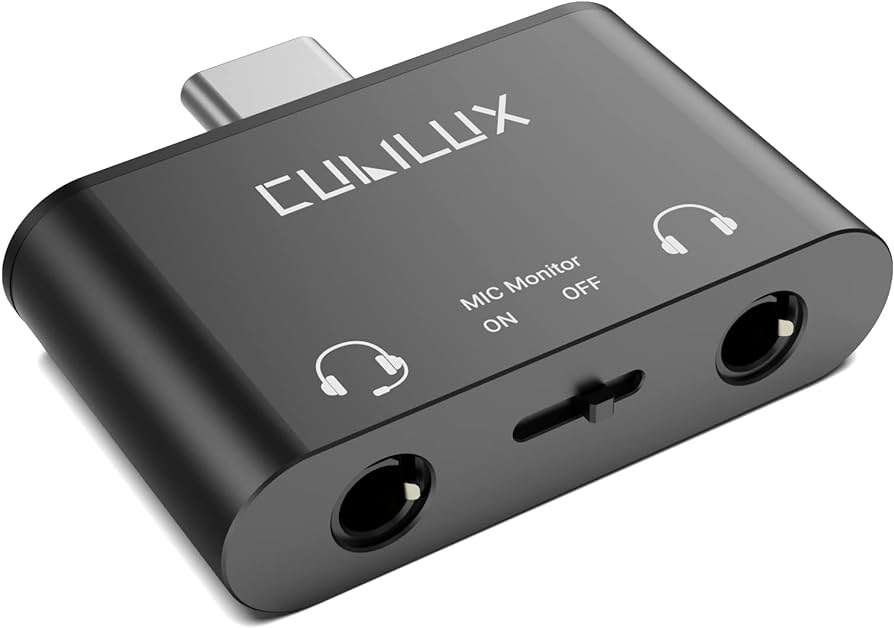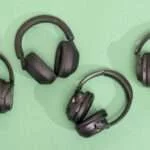In today’s world of shared entertainment experiences, headphone splitters have become essential accessories for those who enjoy listening to music, watching movies, or gaming with friends.
These nifty gadgets allow multiple users to connect their headphones to a single audio source, enabling seamless sharing of audio content. However, with a myriad of options available in the market, choosing the right size headphone splitter can be a daunting task.
Let’s delve into the world of headphone splitters and explore how to select the perfect one for your needs.
Understanding Headphone Splitters
What is a Headphone Splitter?
A headphone splitter is a simple device that divides the audio signal from one headphone jack into multiple outputs. This allows two or more pairs of headphones to be connected to a single audio source, such as a smartphone, tablet, or laptop.
Different Types of Headphone Splitters
- Passive Splitters: These require no power and simply split the audio signal. They’re lightweight and portable.
- Active Splitters: These come with an amplifier, ensuring that the audio quality remains high even with multiple headphones plugged in.
Choosing the Right Size
Size Matters: 3.5mm vs. 1/4 Inch
The most common headphone splitter size is 3.5mm, which is compatible with most smartphones and tablets. However, for professional audio equipment, you might need a 1/4 inch (6.35mm) splitter. Here’s how to choose:
- For Everyday Use: Stick with 3.5mm splitters. They’re widely compatible and ideal for personal devices.
- For Professional Equipment: Opt for 1/4 inch splitters if you’re connecting to mixers, soundboards, or studio monitors.
Number of Outputs
The size of the splitter also refers to how many outputs it has. Common configurations include:
- 2-way Splitters: The most common, allowing two headphones to connect.
- 3-way or 4-way Splitters: These are useful for group settings, but be cautious; sound quality can diminish with more connections.
Length of the Cable
Don’t overlook the cable length! If you’re sharing audio in a confined space, a short cable might work best. However, for a more flexible setup, consider a longer cable to allow movement.

Credit: www.ebay.com
The Mechanics Behind the Magic
At the heart of every headphone splitter lies a simple yet ingenious mechanism. When a sound signal travels from the audio source—a smartphone, tablet, laptop, or any compatible device—it enters the splitter through its input jack.
Inside the splitter, the signal is intelligently divided into multiple streams, each flowing seamlessly into the connected headphones through individual output ports. This process ensures that each listener receives the full audio spectrum without compromise.
Types of Headphone Splitters
When it comes to headphone splitters, there are several types to choose from, each catering to different needs and preferences.
Wired vs. Wireless
Wired headphone splitters are the traditional option and rely on physical cables to connect multiple headphones to the audio source. They are widely compatible with various devices and offer reliable connectivity.
On the other hand, wireless headphone splitters use Bluetooth technology to transmit audio signals without the need for cables, providing greater flexibility and convenience, especially for users who prioritize mobility.
Audio Jack Types
Headphone splitters come with different types of audio jacks to accommodate various devices. The most common jack size is 3.5mm, which is standard for most smartphones, tablets, and laptops.
However, with the advent of newer devices, such as smartphones with USB-C or Lightning ports, headphone splitters with corresponding connectors have also become available.
Multi-port Splitters
Multi-port headphone splitters feature multiple audio output ports, allowing more than two sets of headphones to be connected simultaneously. These splitters are ideal for larger groups or families and are often used in educational settings, group tours, or public transportation.
Standard Headphone Splitters
The quintessential headphone splitter features a straightforward design, typically accommodating two or more pairs of headphones with a single input jack. These versatile splitters are ideal for casual sharing sessions among friends, family members, or colleagues, offering hassle-free connectivity and reliable performance.
Audio Quality Considerations
Signal Loss
The more headphones you connect, the greater the potential for signal loss. This can result in decreased audio quality. Here are tips to maintain sound clarity:
- Choose Active Splitters: They amplify the signal, helping maintain audio quality.
- Limit Connections: If possible, keep the number of headphones connected to a minimum.
Impedance Matching
Impedance can affect how well your headphones perform with a splitter. Check the impedance ratings of your headphones and choose a splitter that matches these ratings to avoid sound distortion.
Compatibility with Devices
Ensure that the headphone splitter is compatible with your specific devices, including smartphones, tablets, laptops, and gaming consoles. Check the type of audio jack required and verify that it matches the ports on your devices.
Ensure Compatibility
Before purchasing a headphone splitter, check its compatibility with your devices. Here’s a quick checklist:
- Check the Jack Size: Ensure your splitter matches the jack size of your devices.
- Device Type: Some splitters may not work with certain devices, like smartphones with protective cases. Consider this when selecting your splitter.
Additional Features
Some splitters come with extra features, such as volume control or built-in microphones. These can enhance your experience, particularly if you’re using the splitter for calls or gaming.
Factors to Consider When Choosing Headphone Splitters
Before purchasing a headphone splitter, there are several factors to take into account to ensure compatibility and functionality.
Number of Ports Needed
Consider the number of headphones you intend to connect simultaneously and choose a splitter with the appropriate number of ports. If you frequently share audio with multiple people, opt for a multi-port splitter to accommodate everyone.
Material and Build Quality
Look for headphone splitters made from durable materials, such as high-quality plastics or metal alloys, to ensure longevity and reliability. Avoid cheaply made splitters that may break easily or degrade in performance over time.
Audio Quality
While convenience is paramount, don’t compromise on audio quality. Look for headphone splitters equipped with high-fidelity audio components and noise-canceling features to deliver crisp, clear sound without distortion or interference.
Budget Considerations
Set a budget for your headphone splitter purchase and explore options within your price range. While there are premium splitters with advanced features, there are also budget-friendly options that offer basic functionality without breaking the bank.
Popular Headphone Splitter Brands
Several brands specialize in manufacturing headphone splitters, each offering a range of products with different features and price points. Here are some popular brands to consider:
- Belkin: Known for its quality and reliability, Belkin offers a variety of headphone splitters with different port configurations and connectivity options.
- Anker: Anker produces affordable yet feature-rich headphone splitters that cater to a wide range of users, from casual listeners to audiophiles.
- Ugreen: Ugreen specializes in audio accessories, including headphone splitters, with a focus on affordability and functionality.
- Apple: For users of Apple devices, Apple’s headphone splitters, such as the Lightning to 3.5mm audio adapter, ensure seamless compatibility and performance.
How to Select the Correct Size Headphone Splitter
Selecting the right size headphone splitter is crucial to ensure compatibility and optimal performance with your devices. Follow these steps to find the perfect fit:
Measuring Headphone Jack Sizes
Before purchasing a headphone splitter, determine the size of the audio jacks on your devices. Most smartphones, tablets, and laptops feature a standard 3.5mm audio jack, but some newer devices may use USB-C or Lightning ports.
Measure the diameter and depth of the jack to ensure compatibility with the splitter’s connector.
Compatibility with Specific Devices
Check the compatibility of the headphone splitter with your specific devices, taking into account the type of audio jack and any additional features or requirements. Some splitters may be designed specifically for certain brands or models, so verify compatibility before making a purchase.
Tips for Finding the Perfect Fit
If you’re unsure about which headphone splitter to choose, consider seeking recommendations from friends, family, or online reviews. Look for the splitter’s positive feedback regarding compatibility, build quality, and audio performance.
Additionally, consult with customer support representatives or visit electronics stores for expert advice on selecting the right size headphone splitter for your needs.

Credit: www.amazon.com
Benefits of Using Headphone Splitters
The use of headphone splitters offers several benefits for individuals and groups alike:
Sharing Audio with Friends and Family
Headphone splitters enable multiple users to enjoy the same audio content simultaneously, fostering shared experiences and bonding moments.
Convenience during Travel or Group Activities
Whether on a road trip, flight, or camping excursion, headphone splitters make it easy to share entertainment without the need for bulky speakers or complicated setups.
Cost-effectiveness Compared to Multiple Headphones
Instead of purchasing multiple pairs of headphones, a single splitter allows users to utilize their existing headphones for shared listening, saving money in the long run.
Top Uses of Headphone Splitters
| Use | Description |
|---|---|
| Sharing Music | Listen to the same song with a friend. |
| Watching Movies | Enjoy movies together on a laptop or tablet. |
| Gaming | Two players can use separate headphones. |
Common Issues and Troubleshooting
While headphone splitters offer numerous benefits, they may encounter occasional issues that require troubleshooting:
Audio Quality Degradation
Poor audio quality, such as static or distortion, may occur due to loose connections or incompatible devices. Ensure that all connections are secure and that the splitter is compatible with your devices.
Loose Connections
Over time, headphone splitters may develop loose connections or wear out, resulting in intermittent audio or loss of sound. Inspect the splitter regularly for signs of wear and tear and replace it if necessary.
Compatibility Issues with Certain Devices
Some devices may not be compatible with certain headphone splitters due to differences in audio jack sizes or proprietary connectors. Verify compatibility before purchasing a splitter and consider using adapters if needed.
Maintenance and Care Tips
To prolong the lifespan of your headphone splitter and ensure optimal performance, follow these maintenance and care tips:
Cleaning Methods
Periodically clean the connectors and ports of the headphone splitter using a soft, dry cloth to remove dust, dirt, or debris. Avoid using liquid cleaners or abrasive materials that may damage the connectors.
Regular Cleaning
Over time, dust, dirt, and debris can accumulate in the input and output ports of your headphone splitter, affecting audio quality and connectivity. Use a soft-bristled brush or compressed air to gently remove any buildup and keep the ports clean and functional.
Storage Recommendations
Store the headphone splitter in a dry, cool place away from direct sunlight and extreme temperatures. Avoid bending or twisting the cables excessively, as this may cause damage to the internal wiring.
Avoiding Physical Damage
Handle the headphone splitter with care and avoid dropping or subjecting it to impact or pressure. Use protective cases or pouches when transporting the splitter to prevent scratches or dents.
Exploring Innovative Applications
While headphone splitters are traditionally associated with audio sharing, their versatility extends far beyond conventional usage scenarios. Here are some innovative applications that showcase the adaptability and creativity of headphone splitters:
Language Learning Sessions
Transform mundane language learning sessions into immersive cultural experiences by using headphone splitters to synchronize audio lessons with foreign language films, music, or podcasts.
By listening together and discussing the content in real time, learners can enhance their comprehension skills and cultural awareness dynamically and engagingly.
Collaborative Audio Editing
In the realm of multimedia production and content creation, headphone splitters serve as invaluable tools for collaborative audio editing and feedback sessions.
Whether it’s fine-tuning a podcast episode, mixing music tracks, or editing sound effects for a film, multiple users can listen in sync and provide real-time feedback, streamlining the creative process and fostering teamwork.
The Future of Headphone Splitters: Innovations on the Horizon
As technology continues to evolve and consumer preferences shift, the future of headphone splitters holds boundless possibilities for innovation and refinement.
From advanced audio processing algorithms to seamless integration with virtual and augmented reality platforms, the next generation of headphone splitters promises to elevate the shared listening experience to new heights of immersion and interactivity.
Where to Buy Headphone Splitters
Online vs. Retail
You can find headphone splitters both online and in physical stores. Here are the pros and cons:
- Online: A wider variety, often at lower prices. Look for user reviews to guide your choice.
- Retail: Immediate availability and the ability to physically inspect the product.
Recommended Brands
Some reputable brands to consider include:
- Hosa: Known for reliable audio equipment.
- AmazonBasics: Offers budget-friendly options.
Belkin: Renowned for quality accessories.
Conclusion
In conclusion, choosing the right size headphone splitter is essential for ensuring compatibility, functionality, and optimal performance with your devices. Whether you prefer wired or wireless options, prioritize durability and compatibility when selecting a splitter.
To choose the best headphone splitter, evaluate device compatibility, the required number of audio ports, and your budget. This ensures you select a splitter that optimally enhances your shared audio experiences.
Frequently Asked Questions about Headphone Splitters
Can I use a headphone splitter with any device?
While most headphone splitters are compatible with a wide range of devices, it’s essential to check compatibility, especially if you’re using newer devices with proprietary connectors.
Will using a headphone splitter affect audio quality?
In some cases, using a headphone splitter may result in slight audio degradation, such as reduced volume or clarity. However, choosing a high-quality splitter and ensuring secure connections can help minimize any potential impact on audio quality.
Can I use a headphone splitter with Bluetooth headphones?
Yes, some headphone splitters support Bluetooth connectivity, allowing you to connect wireless headphones to the splitter via Bluetooth pairing.
How many headphones can I connect to a headphone splitter?
The number of headphones that can be connected to a splitter depends on the number of ports available. Some splitters offer two ports for dual headphone connectivity, while others feature multiple ports for connecting multiple headphones simultaneously.
Are headphone splitters compatible with gaming consoles?
Yes, headphone splitters are compatible with most gaming consoles that feature a standard audio output port. However, some gaming consoles may require additional adapters or accessories for compatibility.

A passionate tech blogger and the founder of Best Tech View, a dynamic platform dedicated to all things technology. With a keen interest in the tech, Ahmad strives to provide insightful and engaging content on the latest tech trends, and breakthroughs.



